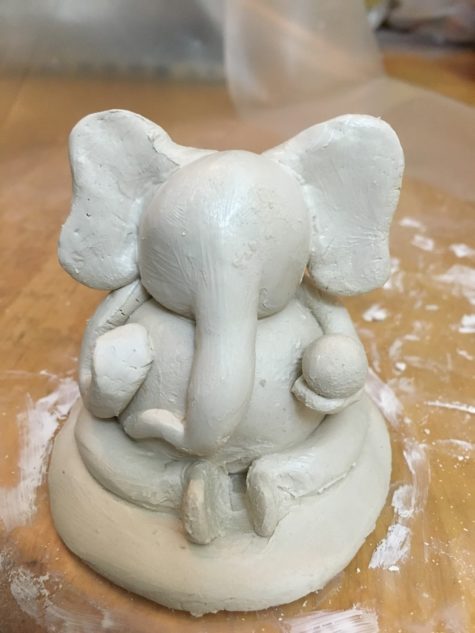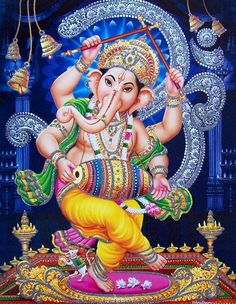DIY
Making A Shrine To Ganesha

Creating a home shrine is not difficult. The altar should be close to the floor if you plan to use it for puja and/or meditation. However when there are small children in the home it is often best to have it higher and out of reach.
For a Ganesha shrine, an image, or murti, of Lord Ganesha is placed at the center of the altar. A metal or stone image is best, but if not available there are two traditional alternatives:
- A framed picture, preferably with a sheet of copper on the back.
- A kumbha, which is a symbol of Ganesha made by placing a coconut on a brass pot of water with five mango leaves inserted between the coconut and the pot. The coconut should be husked but still have the fibers on the top.
Bathing the God’s image (murti) is a part of a puja and other ceremonies. For this, special arrangements may need to be made. Most simply, the murti may be placed in a deep tray to catch the water. After the bath, the tray is removed and the murti dried off, and then dressed and decorated.
Various items for the altar can include:
- Water cups and a small spoon for offering water
- A brass vessel of unbroken, uncooked rice mixed with enough turmeric to turn the rice yellow
- A tray or basket of freshly picked flowers (without stems) or loose flower petals
- A lamp
- Small metal bell
- Incense burner and a few sticks of incense
- Fresh fruit
Borrowed from The Prosperity Project
Ganesha Road Opener Blend

Fill a small bottle with equal parts of the following essential oils:
- Sandalwood
- Honeysuckle
- Hibiscus
Add a few drops of Gardenia essential oil.
Consider all obstacles in your way being removed from your path as you blend this oil, and invoke Ganesha, the remover of obstacles to give his blessings to your blend so that it may be the best oil you use to open all roads to success.
You can use Ganesha Road Opener Oil in a variety of ways. It can be worn on the body, dabbed into the bath, anointed on important documents, dropped in the heel of your shoe, dabbed on charms and talismans, rubbed on the front door, burned in a diffuser or simply worn during prayer or meditation. You may also petition Ganesha by placing out sweets, fresh flowers and a bowl of water with a bit of this oil blend mixed in.
This oil blend should be a basic staple in your collection, and I strongly suggest you keep it on hand to be used whenever needed. Anytime you must clear your way through physical obstacles, this is the oil for the job. Add Road Opener to any magick or impossible task you wish to accomplish.
Add this oil to liquid body soap, and every time you wash your hands, you will be imbuing them with the power to open roads in all that they encounter. Writing letters, doing chores and being involved in all manner of communications – we use our hands one way or another.
Adapted from a recipe in the Enchanted Formulary
Recipe For Modaka
The following recipe will make approximately 20 lime-sized modakas, a treat for the children, and a traditional offering to Lord Ganesha. It takes about two hours to make them.
Ingredients and Utensils:
- 1 lb rice flour
- 2 cups jaggery (or 2 cups brown sugar with 4 tbsp dark molasses added)
- 2 cups raw sesame seeds
- 2 grated coconuts (optional)
- 2 cups melted ghee (melted butter will also work)
- 1 tsp salt
- Banana leaf or waxed paper
- A flour sifter or fine sieve
- An iddli or vegetable steamer
Directions:
Roast the sesame seeds in a pan, without oil, until golden brown (5 to 10 minutes). Crack the seeds by rolling with a rolling pin or pounding. Add 4 tbsp ghee to the jaggery to soften it, and then mix in the sesame seeds and coconut thoroughly. (This mix may be refrigerated in jars for making quick sweets simply by adding a bit of ghee and shaping the dough into balls).
Next sift the rice flour and toast it without oil until it browns slightly – about 5 to 7 minutes. Spread it out on a tray or table top when done, and allow cooling completely.
While the rice flour is cooling, bring approximately a half-gallon of water, with a tsp of salt, to a rolling boil. Put the cooled, toasted rice flour in a bow. And make a well in the middle. Slowly pour a small amount of the hot water into the well and begin working it into the rice flour with your hands.
Keep adding small amounts of the hot water, and work the flour into a ball of dough. It should be moist but not wet when you put it out on the table or breadboard. Knead the dough thoroughly so it is even in moisture and texture.
Next, place water in the bottom of the steamer and bring to a full boil. Spread a thin coating of ghee or oil on a piece of banana leaf or waxed paper. Take a lump of dough half the size of a lime and work it in your hands for a moment to remove the air and then pat it out flat and round on the leaf, about as wide across as your palm. Make it a uniform thickness so it will cook evenly.
Place a lump of the sesame-jaggery-coconut mixture into the center and wrap the dough up around the mixture. Pinch the dough into a cone-shape over the stuffing and wrap the leaf or paper up around it. (The modakas can also be round if desired.) Repeat until you have enough to fill your steamer.
Place the assembled modakas in the steamer, spaced so as to not touch one another. Cover and steam until done (15 to 20 minutes). While they cook you can prepare the next batch. When cool enough to handle, dip the modakas in melted ghee. Now they are ready to offer.
from Loving Ganesa
by Satguru Sivaya Subramuniyaswam
Make a Papier Mache Ganesh
 This is a simple method for a paper mache Ganesh. Some artistic ability is helpful, but if you are willing to simply get in there and have fun, it might surprise you how easy it could turn out to be!
This is a simple method for a paper mache Ganesh. Some artistic ability is helpful, but if you are willing to simply get in there and have fun, it might surprise you how easy it could turn out to be!
The materials needed are:
- Paper mache
- Latex or other water-based paint in a variety of colors
- Gold-leaf or metallic gold paint
- Paint brushes
- Sand paper
- Putty or joint compound
- Miscellaneous ornaments and cloth for dressing the image
- Replicas of the various implements he will be holding
Instructions:
- Mix paper mache to a firm but homogeneously wet consistency.
- Make an armature (skeleton) of wood, Styrofoam, or similar material.
- Create the image by covering the armature with paper mache.
- Make implements for each hand and make sure they can be inserted and glued later when the image is dry
- Brush the exterior smooth with a wet brush.
- Let the image dry in a cool place, away from the sunlight. (Drying time is usually one month for every foot in height for a clay image, three weeks for paper mache.)
- When dry, sand with coarse, then fine sandpaper
- Fill cracks with putty or joint compound.
- Sand again
- Apply a white primer and sand with very fine sandpaper.
- Make the image dust-free.
- Paint the torso, head, trunk, and limbs
- Use red paint and a fine brush for the Aum, swastika, and other – symbols.
- Paint, decorate, and/or assemble the various implements
- Place appropriate dress (traditionally white or red silk) upon the image.
- Glue the implements into the hands
- Decorate the image with ornaments, flowers, etc.
adapted from Loving Ganesa
by Satguru Sivaya Subramuniyaswami
An alternative method can be explored with this visual tutorial from Hobby Ideas:












